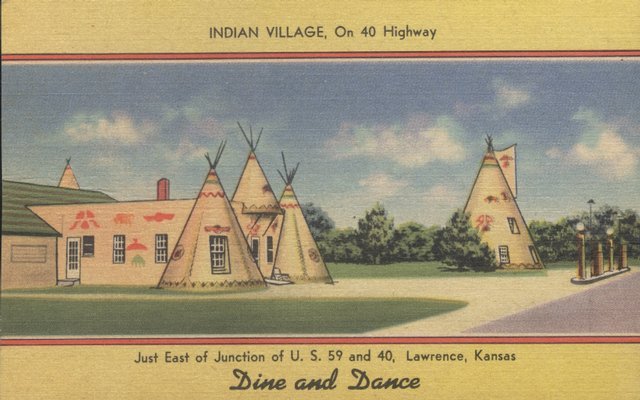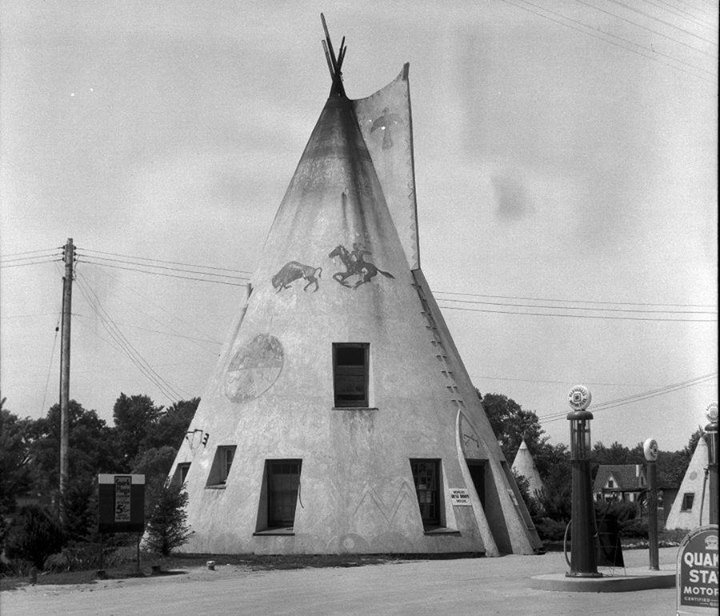“Beer can be served and a respectable atmosphere preserved.”
What do you do when your dream of a chain of specialty service stations from here to the west coast disappears into the maw of the Great Depression almost as soon as you’ve broken ground? You turn to beer. (Literally.)
Lawrence’s iconic piece of American roadside kitsch was built nearly 90 years ago by then-Haskell athletic director Frank W. McDonald. McDonald first began at Haskell as an assistant football coach in 1920, hired as part of efforts to bring attention and fame to the school through football (as had worked for the Carlisle Indian School in Pennsylvania with coach Pop Warner and star athlete Jim Thorpe). McDonald had a flair for promotion, engineering several successful east coast football barnstorming tours in the mid-twenties for Haskell’s team, where he saw firsthand the fascination city dwellers had for all things “Indian.”
!n 1928, while still at Haskell, McDonald would apply his promotional acumen for all things “Indian” with a new business venture: Lawrence’s first motel. Having purchased land north of Lawrence where a confluence of major roadways was planned, he came up with the idea for a motor court consisting of a large central concrete teepee/service station and sixteen small teepees for travelers to stay in. But this was only the first step: he partnered with Sinclair Oil to build a series of these “Indian Villages” across the West, located about a day’s travel from each other near Indian reservations and staffed with Native Americans.
Frank McDonald’s original Indian Village promotional brochure. Via the Kansas State Historical Society.
It would be a few years yet before McDonald would build the main service station/teepee structure. Formal plans were revealed in a January 14, 1930 article of the Lawrence Journal-World for a 40 foot tall building with a store on the first floor and a small apartment on the second. Ultimately, several Haskell students (many associated with the football team) helped design and build the structure, and were responsible for decorating and painting it. A few even worked there while wearing “traditional” garb.
via the Lawrence Journal-World http://bit.ly/1DWFoA9
The main service station teepee opened on May 30, 1930, to much fanfare. McDonald even placed a self-congratulatory ad in the paper the next day:
A few months later the curio shop and barbeque were completed, forming what would be the bulk of the business. The Great Depression was already unfolding, and Sinclair Oil had already pulled out of the arrangement (notably, the station served Conoco gasoline when it opened), dashing McDonald’s dream of a nationwide chain. And while two or three smaller teepee cabins were built by 1931, they aren’t mentioned in reports about damage suffered by Indian Village structures during a 1935 flood and don’t appear in photos at the time. The motel chain was not to be.
But a new opportunity was just around the corner for Frank McDonald and his Indian Village. Prohibition was on the way to ending after the 1932 elections, and at some point in 1933, he secured what was claimed to be the first beer distributorship in Kansas (he and his descendants would own the Anheuser-Busch distributorship in Lawrence until 1999). He constructed a beer garden and dance hall between the existing restaurant and service station and opened it to the public on August 10, 1933:
The flood of 1935 would only temporarily put the restaurant and beer garden out of action, but a fire on Sept. 19, 1938 would soon change the site for good:



McDonald vowed to rebuild and he did, enlarging the structure and enclosing two of the teepee corners along the south, creating the footprint of the structure that is there today:
1948 photo of Tepee Junction restaurant building via Raymond Stone
With this enlarged structure, the business would go on to find enduring success as a place for parties and gatherings over the years. The main teepee continued on as simply an unusual gas station - no Native Americans would staff it after the initial summer and the costumes were dropped as well. The massive flood in 1951 inundated the reception hall and the teepee, but once the water receded and cleanup was completed, receptions and parties resumed and the gas station reopened. The only visible change was a line on the teepee marking the height of the floodwaters. The Indian Village name was lost around this time as well. Its status as a navigational landmark at the convergence of two major highways eroded the various names that different operators had given it, and by the 1950’s it simply became “Teepee Junction” to Lawrenceians.
In 1979, the teepee briefly took on a new life as a place for art pottery. The service station had closed in the mid-1970’s and the teepee sat empty. At the time, recently retired KU ceramics professor Bill Bracker and his wife Anne were looking for a spot to construct a powerful kiln that could handle the kind of firings they wanted to do. The McDonald family still owned the property, but Frank McDonald’s daughter-in-law, Barbara, was an artist who had taken classes at KU from Bill. The property was perfect for the kiln, and the Brackers rented the teepee itself as their storefront to sell the pottery they were making, eventually adding direct sales of ceramics supplies and clays. By 1985, the business had grown too big for the teepee itself and moved to a warehouse less than a mile away. Barbara McDonald continued using the building as a private pottery studio for several more years.
The building received a complete makeover in 2008 inside and out. (Anne Bracker said when her business was there in the 1980s, fine silt from the 1951 flood would still come floating out of the walls every time a heavy truck rumbled by on the highway.) The external decorations were repainted by Lawrence artist Joanne Renfro to look as they did the day it opened. But while the upstairs apartment has been intermittently occupied over the years, the inside of the teepee building has remained closed to the public since the Brackers closed their studio showcase.
Special thanks to Anne W Bracker of Bracker’s Good Earth Clays for sharing her memories of the Indian Village Teepee
For a deeper look at the complex cultural issues involved in the creation of the Indian Village, see Keith Sculle’s 1991 article in Kansas History magazine
Trivia Bonuses
Basic Trivia: The “traditional garb” worn by the Haskell students employed at the Indian Village that first summer were made from scratch by Frank McDonald’s wife.
Bar trivia: Frank McDonald sought and received a patent on his design for the main teepee building. Design patent 82442 was granted on Nov. 4, 1930.
Showing off trivia: About that beer distributorship: yes, prohibition didn’t officially end until December of 1933. But on March 22, 1933, an amendment to the Volstead Act, known as the Cullen–Harrison Act, was signed into law by FDR allowing the manufacture and sale of 3.2% beer. This made 3.2 beer legal under the federal statute that enabled enforcement of the 18th Amendment, but once the 21st Amendment repealed the 18th, states were allowed to decide if they wanted to stay dry, which Kansas did, emphatically, in a statewide referendum in 1934. This technically made even 3.2 beer illegal again in Kansas. 3.2 beer would not return as a legal product in Kansas until 1937, and it is unclear if McDonald operated his distributorship (and the beer garden at Indian Village) during this time.
LFK Trivia: A scene from the 1988 movie “Kansas” starring Matt Dillon and (in a small role) Kyra Sedgwick was filmed at the teepee. The film’s set decorators had spiffed up and added gas pumps to make it appear to be a working gas station. Kevin Bacon slipped into town while the scene was being filmed in order to surprise his then-girlfriend Sedgwick.
Cindy Bracker and Anne M Bracker with Matt Dillon at the teepee during the filming of “Kansas”








